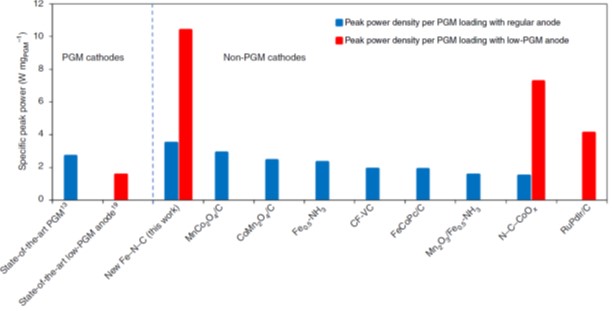Low-temperature polymer electrolyte fuel cells need to overcome considerable cost barriers to be considered as the ultimate power source for transportation systems and portable devices. Although the estimated cost of a proton-exchange membrane fuel cell (PEMFC) has been markedly reduced, it has plateaued in recent years, which has led to the consideration of anion-exchange membrane fuel cells (AEMFCs). Compared to PEMFCs, AEMFCs could lower the cost by allowing for cheaper membranes, a wider class of materials for bipolar plates, enhanced oxygen reduction reaction (ORR) kinetics, and usage of platinum group metal (PGM) free cathode catalysts. In a recent paper published in Nat. Energy (Nature Energy, 2021, 6, 834-843, https://doi.org/10.1038/s41560-021-00878-7), the authors created and studied commercial Fe-N-C catalyst that shows promising potential for AEMFCs.
The aims of the study include: 1) understanding the influence of structure on the behavior of Fe-N-C catalysts with single-atom Fe-Nx active sites in the AEMFC cathode; 2) developing and deploying ultralow-PGM-loading PtRu/C anodes and pairing them with the Fe-N-C based cathodes to create an AEMFC that is able to meet the long-term US Department of Energy (DOE) performance goals.
The characterization results of a representative Fe-N-C catalyst particle showed that Fe was well-dispersed over the entire catalyst and the catalyst composition was homogeneous. Importantly, both N and Fe were clearly evenly dispersed throughout the catalyst. The ex-situ electrochemical evaluation of the Fe-N-C catalyst towards the ORR suggests that the catalyst has very high activity and less than 1% H2O2 yield, indicating a good PGM-free catalyst toward the ORR. Such high activity, in addition to its high surface area and open structure, makes the Fe-N-C catalyst studied here an ideal replacement for PGM materials in the AEMFC cathode.
The authors then assembled AEMFCs with the specific goal of meeting the DOE 2022 milestone for AEMFCs (Beginning-of-life operating voltage of 0.65V at 1 A cm-2 with H2/O2 reacting gases with a total PGM loading of less than 0.2 mg cm-2). To achieve this, an Fe-N-C cathode was pared with an anode with a very low loading of PtRu/C (0.125 mgPGM cm-2/0.08 mgPt cm-2). Under steady-state operation at 1 A cm-2, the cell was able to achieve a stable operating voltage of 0.66 V. The very low PGM-loading cells were also able to support a high peak power density of 1.3 W cm-2 under H2/O2 reacting gases, yielding a remarkable specific power output of 10.4 W per mg PGM.
The results presented in this study demonstrated that PGM-free AEMFC cathodes can surpass the long-difficult DOE target. The study showed promising potential to move the field forward towards completely PGM-free AEMFCs with high performance and long life.


